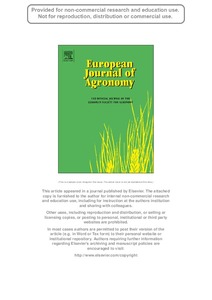| dc.contributor.author | Bucagu, C. |
| dc.contributor.author | Vanlauwe, Bernard |
| dc.contributor.author | Giller, Ken E. |
| dc.date.accessioned | 2019-12-04T11:03:44Z |
| dc.date.available | 2019-12-04T11:03:44Z |
| dc.date.issued | 2013 |
| dc.identifier.citation | Bucagu, C., Vanlauwe, B., & Giller, K. (2013). Managing Tephrosia mulch and fertilizer to enhance coffee productivity on smallholder farms in the Eastern African Highlands. European Journal of Agronomy 48:19-29. |
| dc.identifier.issn | 1161-0301 |
| dc.identifier.uri | https://hdl.handle.net/20.500.12478/1212 |
| dc.description.abstract | In Maraba, Southwest Rwanda, coffee productivity is constrained by poor soil fertility and lack of organic mulch. We investigated the potential to produce mulch by growing Tephrosia vogelii either intercropped with smallholder coffee or in arable fields outside the coffee, and the effect of the mulch on coffee yields over two years. Two accessions of T. vogelii (ex. Gisagara, Rwanda and ex. Kisumu, Kenya) were grown for six months both within and outside smallholder coffee fields in the first year. Experimental blocks were replicated across eight smallholder farms, only a single replicate per farm due to the small farm sizes. The accession from Rwanda (T. vogelii ex. Gisagara) grew more vigorously in all experiments. Soils within the coffee fields were more fertile those outside the coffee fields, presumably due to farmers’ long-term management with mulch. Tephrosia grew less well in the fields outside coffee, producing only 0.6–0.7 Mg ha?1 of biomass and adding (in kg ha?1) 19 N, 1 P and 6 K in the mulch. By contrast, Tephrosia intercropped with coffee, produced 1.4–1.9 Mg ha?1 of biomass and added (in kg ha?1) 42–57 N, 3 P and 13–16 K in the mulch. Coffee yields were increased significantly by 400–500 kg ha?1 only in the treatments where Tephrosia was intercropped with coffee. Soil analysis and a missing-nutrient pot experiment showed that the poor growth of Tephrosia in the fields outside coffee was due to soil acidity (aluminium toxicity) combined with deficiencies of P, K and Ca. In the second year, the treatments in fields outside coffee were discontinued, and in the coffee intercrops, two Tephrosia accessions were grown in treatments with and without NPK fertilizer. Tephrosia grew well and produced between 2.5 and 3.8 Mg ha?1 biomass for the two accessions when interplanted within coffee fields, adding 103–150 kg N ha?1, 5–9 kg P ha?1 and 24–38 kg K ha?1. Tephrosia mulch increased yields of coffee by 400 kg ha?1. Combined use of NPK + Tephrosia mulch increased Tephrosia biomass production and in turn yielded an additional 300–700 kg ha?1 of coffee. Over the two years, this was equivalent to a 23–36% increase in coffee yield using Tephrosia intercropping alone and a further 25–42% increase in coffee yield when NPK fertilizer was also added. Agronomic efficiency (AE) of nutrients added were 30% greater when the Tephrosia mulch was grown in situ and the two cultivars of Tephrosia did not differ in AE. The AE of Tephrosia mulch was 87% that of NPK fertilizer, reflecting the rapid mineralization of Tephrosia mulch. There was a synergistic effect of Tephrosia mulch on the efficiency with which NPK fertilizer was used by coffee. The increase in coffee yields was positively related to the amount of nutrients added in the Tephrosia biomass. Tephrosia intercropping required 30 man-days ha?1 less than current farmer management due to reduced labour required for weeding, and benefit–cost ratios ranged between 3.4 and 5.5. The Tephrosia-coffee intercropping system offers great potential for agroecological intensification for smallholder farmers in the East African highlands. |
| dc.format.extent | 19-29 |
| dc.language.iso | en |
| dc.subject | Intercropping |
| dc.subject | Tephrosia |
| dc.subject | Coffee |
| dc.subject | Smallholder Farmer |
| dc.title | Managing Tephrosia mulch and fertilizer to enhance coffee productivity on smallholder farms in the Eastern African highlands |
| dc.type | Journal Article |
| dc.description.version | Peer Review |
| cg.contributor.affiliation | Wageningen University and Research Centre |
| cg.contributor.affiliation | International Institute of Tropical Agriculture |
| cg.contributor.affiliation | National University of Rwanda |
| cg.coverage.region | Africa South Of Sahara |
| cg.coverage.country | Rwanda |
| cg.isijournal | ISI Journal |
| cg.authorship.types | CGIAR and advanced research institute |
| cg.iitasubject | Coffee |
| cg.journal | European Journal of Agronomy |
| cg.howpublished | Formally Published |
| cg.accessibilitystatus | Limited Access |
| local.dspaceid | 78460 |
| cg.targetaudience | Scientists |
| cg.identifier.doi | https://dx.doi.org/10.1016/j.eja.2013.02.005 |

